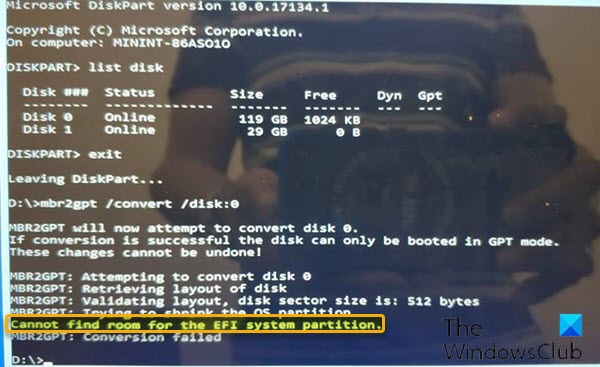

- #Cannot create efi system partition mbr2gpt upgrade#
- #Cannot create efi system partition mbr2gpt full#
- #Cannot create efi system partition mbr2gpt windows 10#
- #Cannot create efi system partition mbr2gpt windows 7#

If you have systems that the OS disk is showing up on Disk 1, then be sure to create multiple steps with conditions.Īfter selecting the disk number in my MBR_RecoveryPartition.txt file, the first thing I do is select the Windows partition (#2) and shrink it by 499 MB (to keep within the Recovery Partition parameters). NOTE: this is statically set to Disk 0 (like the Format and Partition Disk step). This Task Sequence step directly after this is a Run Command Line step that calls diskpart with an answer file (with the same conditions as the Format and Partition Disk step). By leaving this to 99%, this leaves a lot of space for the recovery partition on really large disks when we only need about 499 MB. On the Windows partition, I now set this to 100% of the remaining space on the disk and notice that OSDisk variable that gets assigned for later use. Now this is what my Format and Partition Disk step looks like for BIOS systems: For the Recovery partition, I create this right after the Format and Partition Disk step using a diskpart script in a Package. The reason for this is that I can assign the Windows partition to an OSD variable (which can be useful later on in the Task Sequence). When creating partitions for BIOS based systems, I still like to use the built-in Format and Partition Disk step for creating the System Reserved and the Windows partitions. Luckily, there are a few things that can be done to avoid both of these issues. This is still bad because we end up with 4 partitions and that does not work well for MBR2GPT. In my testing, it never attempted to resize the partition and always created another Recovery partition after the Windows partition. During the upgrade, what should happen is setup should either resize the existing partition or create a new one if needed (see /ResizeRecoveryPartition switch description from the Windows Setup Command-Line Options).
#Cannot create efi system partition mbr2gpt windows 10#
Even if the Recovery partition that Configuration Manager created was the correct type, it would need to have a certain amount of free space based on its size in order for the Windows 10 Setup to be able to use it (see BIOS/MBR-based hard drive partitions for details on the Recovery tools partition sizes). This is why the system is ending up with four partitions. When the Windows 10 Setup runs, it does not recognize (or use) the Recovery partition that was created by Configuration Manager and proceeds to create a proper 450 MB hidden Recovery partition after the Windows partition. The Recovery partition is getting set to type 7 instead of type 27 (hidden). Behind the scenes, it creates a diskpart answer file that it uses to partition and format the disk. The problem is with the highlighted Partition Disk 0 – BIOS step.

#Cannot create efi system partition mbr2gpt windows 7#
The test system was first built from the following Configuration Manager Windows 7 OSD Task Sequence: After further investigation, it appeared that there were now two Recovery partitions (which seemed a bit odd): After inspecting the disk layout, I noticed that there were 4 partitions (MBR2GPT can only work with 3 or less since it needs to create the EFI partition). Only one little problem, MBR2GPT was not able to convert the disk (and I even managed to make it crash, but that is another story). Run MBR2GPT (supported and recommend method is to run in this version of WinPE)ĥ.
#Cannot create efi system partition mbr2gpt upgrade#
Once upgrade is done, reboot into WinPE 1703Ĥ. In-place Upgrade to Windows 10 (still in Legacy BIOS after upgrade)ģ. Deploy TS to current OS (can be Win7/8/8.1/10) running in Legacy BIOS modeĢ. The high-level process goes something like this:ġ. The version of this Task Sequence flips the machine from BIOS to UEFI using the new MBR2GPT utility. This led me to discover a couple of issues around Configuration Manager (specifically the Format and Partition Disk step) and Windows 10 Recovery partitions.
#Cannot create efi system partition mbr2gpt full#
As I was preparing for my Midwest Management Summit 2017 session, Building the Ultimate Windows 10 UEFI Task Sequence, I did a full end-to-end run of the In-place Upgrade Task Sequence and started running into issues.


 0 kommentar(er)
0 kommentar(er)
